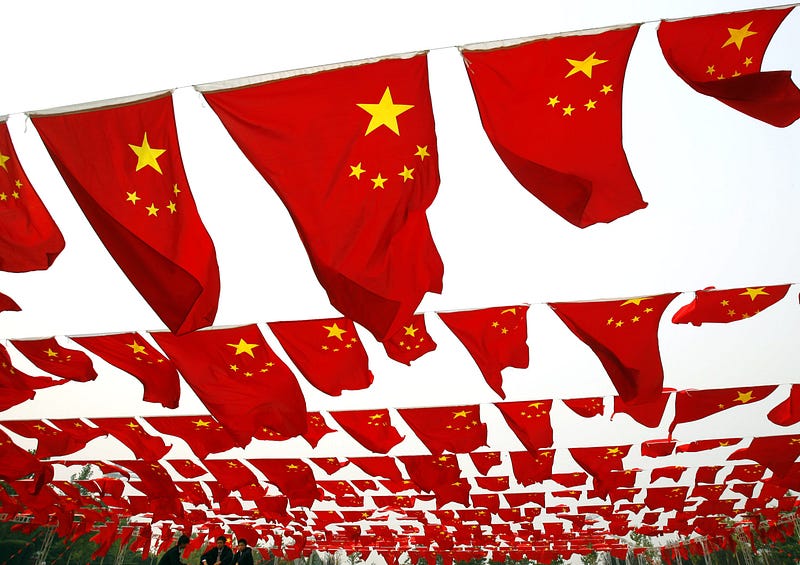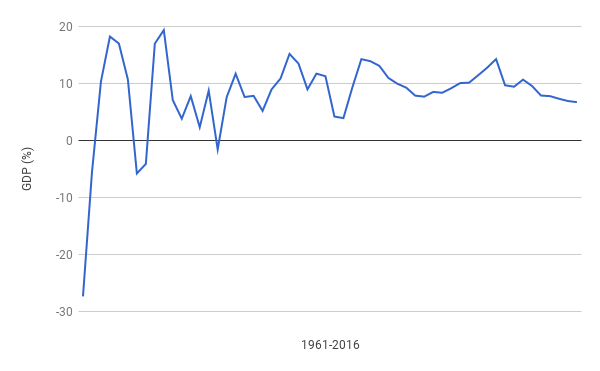 InSeptember, the chairman of the Joint Chiefs of Staff told Congress he believes China will pose the “greatest threat” to the United States by 2025. It’s something we’ve been hearing a lot of from commentators: Is China a rising superpower? Will it someday displace the United States as the world’s most powerful country? Will the United States and China go to war?
InSeptember, the chairman of the Joint Chiefs of Staff told Congress he believes China will pose the “greatest threat” to the United States by 2025. It’s something we’ve been hearing a lot of from commentators: Is China a rising superpower? Will it someday displace the United States as the world’s most powerful country? Will the United States and China go to war?
In short, the answers are: no, very unlikely, and probably not.
Obviously, no one can predict the future, but the “threat of China” has been seriously overblown. To be sure, China is a rising power and expanding its global influence, but there is no reason to believe it’s on the cusp of becoming a superpower that could rival the likes of the United States.
It’s true that China has the world’s largest population, and its economy has expanded rapidly over the past several decades. However, China has enormous problems that stand in its way of becoming a potential superpower. Furthermore, though the “decline of American power” is a real phenomenon, the United States is likely to remain the superior actor (though the decline is, in many ways, self-inflicted).
China Is Still a Poor Country
By many measures, China’s economy is doing quite well. Its GDP is worth $11 trillion (ranked second only to the United States), its economy grew 6.7 percent in 2016, and it has lifted hundreds of millions of people out of extreme poverty over the past few decades.
However, a closer look reveals that China has significant problems. First, though the country’s economic growth is still quite impressive, the rate has slowed and is unlikely to reach double-digit growth again:
 Data: World Bank
Data: World Bank
Furthermore, in per capita terms, China’s GDP is quite low: just over $8,000and ranked below such countries as Costa Rica, Romania, and Equatorial Guinea. (The per capita GDP of the United States is more than $57,000.)
In addition, China’s impressive GDP numbers are actually somewhat misleading. A substantial portion of China’s “exports” that drives its GDP are anything but. Take, for example, the iPhone — turn it over and you’ll see that it says “Made in China.” But this isn’t really true. The iPhone is designed in the United States, and most of its component parts are manufactured in Taiwan and South Korea. These parts are then shipped to China, where the iPhone is assembled by low-wage workers and then exported. It isn’t really “made in China”; it is merely assembled there.
As the political economist Sean Starrs has pointed out, “China’s rise is assembled in China but designed in the United States.” This is because “it is foreign corporations — especially American — that ultimately own and profit by far the most from the bulk of the internationally oriented sectors in China.”
As Starrs explains, “The traditional way of conceptualizing national power,” including a measure like GDP, is inadequate in the era of globalization when transnational corporations have operations spread across the world. “Even though China has a virtual monopoly on the export of iPhones, for instance, it is Apple that reaps the majority of profits from iPhone sales. More broadly, more than three-quarters of the top 200 exporting firms from China are actually foreign, not Chinese,” Starrs says.
Overall, China is ranked 90th on the Human Development Index. Its two wealthy neighbors, Japan and South Korea, are ranked 17th and 18th, respectively. The United States is ranked 10th. (Norway is ranked first.) Though China continues to improve its HDI values, the rate of its progress has slowed and is mostly stuck at around its current numbers.
Another problem China will have to confront is its aging population—a “looming societal crisis,” as Howard W. French explains in the Atlantic:
China today boasts roughly five workers for every retiree. By 2040, this highly desirable ratio will have collapsed to about 1.6 to 1. From the start of this century to its midway point, the median age in China will go from under 30 to about 46, making China one of the older societies in the world. At the same time, the number of Chinese older than 65 is expected to rise from roughly 100 million in 2005 to more than 329 million in 2050 — more than the combined populations of Germany, Japan, France, and Britain.
With more people exiting the workforce than entering it, economic growth will inevitably slow. Indirectly, it will probably also decrease the likelihood of a military conflict with outside powers such as the United States, because China will be forced to dedicate resources to care for its elderly instead of spending on the military.
Beyond this, China has huge environmental problems. China is the world’s largest emitter of greenhouse gases. As Eleanor Albert and Beina Xu write in a backgrounder for the Council on Foreign Relations:
The country’s energy consumption has ballooned, with reports from late 2015 implying that it consumed up to 17 percent more coal than previously reported. In January 2013, Beijing experienced a prolonged bout of smog so severe that citizens dubbed it an “airpocalypse”; the concentration of hazardous particles was forty times the level deemed safe by the World Health Organization (WHO). In December 2015, Beijing issued red alerts for severe pollution — the first since the emergency alert system was established. The municipal government closed schools, limited road traffic, halted outdoor construction, and paused factory manufacturing. At least 80 percent of China’s 367 cities with real-time air quality monitoring failed to meet national small-particle pollution standards during the first three quarters of 2015, according to a Greenpeace East Asia report.
As Albert and Xu write, water depletion and pollution are also major problems: 90 percent of its water supplies are dedicated to either the agriculture or coal industries, leaving two-thirds of China’s cities with water shortages. More than a quarter of China’s key rivers are “unfit for human contact” because of pollution, and more than a million square miles of China’s landmass is undergoing desertification because of “negligent farming practices, overgrazing, and the effects of climate change.”
The United States Versus China
China is aware of its problems and is doing what it can to solve and mitigate them; for example, becoming a leading investor in renewable energy. But the country clearly has a long way to go before it becomes as powerful and rich as a first-world country like the United States.
That’s not to say that the “rise of China” — such as it is — isn’t in some ways threatening, with its island building and expansion into the South China Sea. It may also bring opportunities. China’s “Belt and Road” initiative — the country’s investment in numerous infrastructure projects along the old Silk Road across Eurasia — could lead to greater regional integration, more prosperity, and a decline in ethnic/religious tensions. China is similarly investing in infrastructure projects in Africa.
In many ways, what China is trying to do is overcome its “century of humiliation” (when China was subject to Western and Japanese imperialism from the mid-19th to the mid-20th centuries) and reestablish something like the tributary system that used to exist in the region.
To an extent, it’s probably inevitable, but it’s important to bear in mind all the problems China still faces, as discussed above. While the “decline of American power” is real, it is not as severe as some say, and there’s no reason to believe the center of world power will shift from the United States to China.
When it comes to American power, it probably peaked at the end of World War II, when the United States emerged as the strongest and most economically dominant country, with much of the rest of the world in ruins. Soon, however, Europe, Japan, and the Soviet Union recovered, and, naturally, U.S. power declined somewhat. When the communists emerged victorious in China’s civil war, U.S. power declined further. So the “decline of American power” is nothing new.
To the extent that it’s happening, however, much of it is self-inflicted. Rather than fretting about China, the United States could instead look at what it is doing to itself: Its formal democratic institutions are increasingly failing to reflect popular opinion. It lacks the basic social safety-net programs that comparable countries have. It’s going backwards with climate change policy, leaving China to take the lead. Its wars in the Middle East have resulted in widespread devastation and growth in jihadist terrorism at the cost of trillions of dollars. Its animosity toward a declining power like Russia is only drivingMoscow into Beijing’s arms. And apparently enough of the country’s citizens are so disgusted with the status quo that they are willing to vote for a narcissistic reality TV host for president.
Despite all this, the United States will remain far more powerful. It spends far more on its military than China or any other country. In 2016, U.S. military spending was $611 billion (3.3 percent of U.S. GDP) while China spent $215 billion (1.9 percent of its GDP). In September, the Senate voted 89–8 to increase military spending to $700 billion, more than what President Trump wanted. (The American Empire is a bipartisan project.) While China is increasing its military budget as well, its increase is the smallest in decades.
Beyond the actual spending, however, the U.S. military remains far better trained and technologically sophisticated, despite China’s increasing modernization of its military forces. Its single aircraft carrier — “a refurbished secondhand vessel” — doesn’t compare to the U.S. Navy’s multiple supercarriers that “dwarf all other flat-tops worldwide both in size and capability,” according to Popular Mechanics. China has a nuclear arsenal of 270 weapons, while the United States has about 6,800.
Furthermore, U.S. military superiority in the region is amplified by arms sales and security agreements with various countries in the region: Japan, South Korea, Taiwan, and the Philippines. In addition, the United States has more than 73,000 of its troops stationed in Asia, mostly in Japan and South Korea. China has nothing comparable — either in the region or near the United States.
The “rise of China” is real, but not as profound or significant as many U.S. commentators assume, just as the “decline of American power” is real, which is similarly not as profound or significant as those same commentators lament. It is clear there are challenges ahead, and both the U.S. and Chinese governments are likely to engage in counterproductive actions endangering the peace. The responsibility for keeping that peace thus falls to the citizens of both countries.
No comments:
Post a Comment